(Get free painting tips and plein air painting techniques sent straight to your inbox or on my social media.)
Reflected Light
The light on this street in Marrakesh was incredible. The shadows seemed to glow as if they had some magic light source. It seemed so intense. But how to paint light? That was my challenge in this painting: how to paint the light. Here are two useful tips I discovered.
Above is some video I took of the experience of creating the painting below. The video is a bit long and unedited, but will give you an idea of the reality of what I was dealing with, as well as showing you some of the progression of my painting. Hopefully it will give you some ideas for how to paint light.
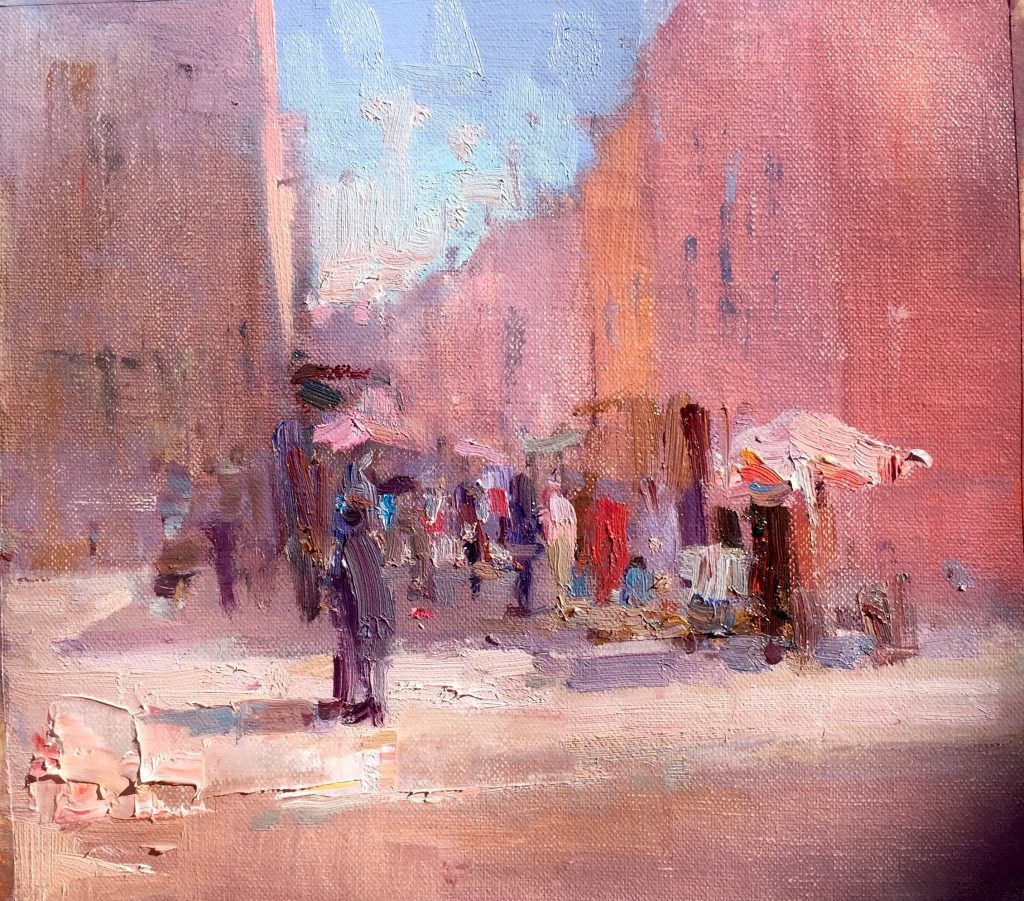
Cat. No. 1319 Arset el Mellak, Marrakesh – 22cm x 30cm – Oil on Linen
How To Paint Light Tip No. 1 The Washes
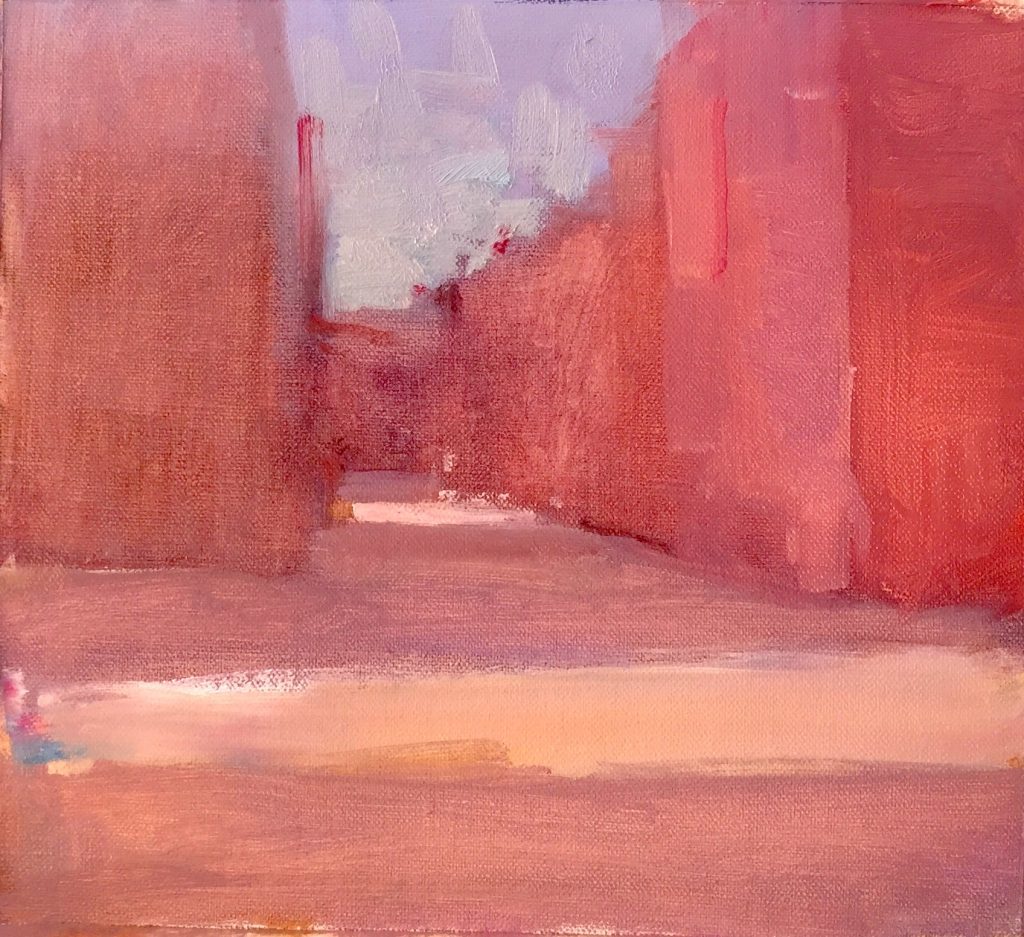
This is somewhere in the early process of how I started the painting. I was using transparent oil washes. I started off using pure pigments thinned with odorless mineral spirits in an almost a watercolor-like technique. And only later moved to more opaque pigment by adding titanium white to my colors. At this point I was exploring how to paint light in the shadowed street in the background before attempting any detail. The effect of all these washes was to create a multi-colored imprimatura.
How To Paint Light Tip No. 2: Ignore the Photograph
There was no way to capture the feeling and effect of this light in a photograph. You had to be there to see it. If you look at this photograph you don’t get the proper feeling of light. This is because the shadowed area of the street is quite dark in the photograph.
In reality, when you are actually there, the iris of your eyes adjusts to the shadows to let in more light, and the extremely strong reflected light makes the shadows appear much lighter and saturated in color. Actually the painting captured the feeling quite well. The photograph does not come anywhere close.
So in order to paint light you need to have some plein air experience so that you know how to interpret a photograph.
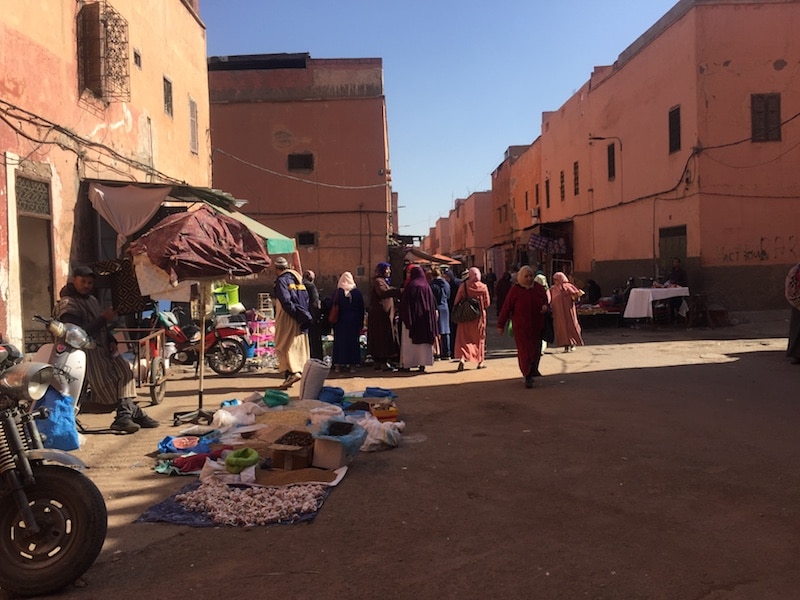
Above is a photo of the actual scene I was painting.
The Dynamic Range Camera Problem
In order to learn how to paint light, if you work from photographs you need to understand the dynamic range camera problem.
The problem with photography
When we look at shadows, our eyes adjust to let in more light (our pupils dilate). This means that we can see color in shadows. When we look back at a bright light, our eyes adjust to block some of the light so we can better see the light areas.
However, the camera has a limited dynamic range compared with the human eye. Each time you take a photograph of a scene that has areas that are very dark and areas that are in bright sunlight you can either:
- get the shadow colors accurate, but the areas in bright sunlight will be ‘washed out’. That is to say they will appear white and have no color in them, when in reality they would have a definite color and hue and a much higher saturation, or
- get the bright light colors accurate, but at the same time the areas in the shadows will appear black. They will have no color in them, when in reality they would be a gray color with a definite hue.
The solution
There is not much you can do about this problem, which is why plein air paintings are so much livelier and real than studio paintings made from photographs. Some suggestions are:
- use a high end camera with a high dynamic range
- use the HDR setting on your camera or smart phone
- take two photographs, one exposed for the darks and the other exposed for the lights
- if you take only one photograph, under expose it a bit so that the lights retain their color. You can then use computer software to retrieve the colors in the shadows. You cannot do it the other way around. If you expose for the darks and the whites are ‘washed out’, you cannot retrieve them in software.
- use the Zone System.
What the eye can see
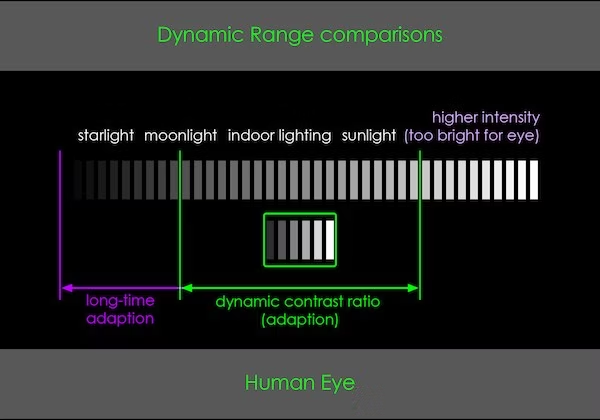
What the camera can see relative to the human eye
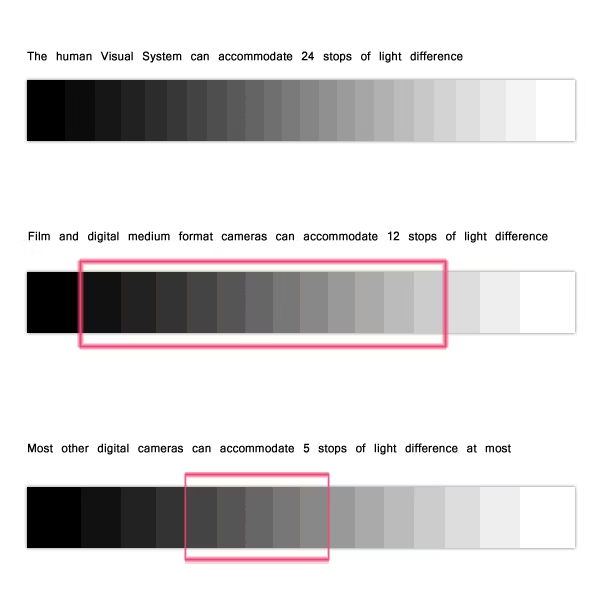
Implications for color matching
Now this is where things get complicated.
Painting indoors
When painting indoors in a room that has no direct sunlight, matching colors is relatively easy. The same amount of light falls on the subject as your painting.
This means you can hold patches of paint up to your subject to check they are the same as the color spot on your subject (usually a still life, but it could be a portrait). Since the same amount of light is falling on your subject as is falling on your painting, you will very easily be able to match the colors and achieve a very highly realistic still life painting. This is the trick that methods such as ‘The Carder Method’ (now marketed as something else), and a lot of painting courses on the internet use. Easy stuff!
Painting plein air
This method completely falls apart when painting plein air. The reason is because of this common painting rule:
You will perceive a black object that has light falling on it to be lighter in value than you perceive a white object in the shadow.
(Some artists phrase this rule as: “the darkest dark in the lights is always lighter than the lightest light in the darks”)
In other words black can be lighter than white!
Conversely:
You will perceive a white object that is in the shadow to be darker in value than a black object that has light falling it”.
(Some artists phrase this rule as: “the lightest light in the darks is always darker than the darkest dark in the lights”)
This means that if your painting is either all in the shadow or all in the light, and your subject is half in shadow and half in light, the system of matching swatches of color with your subject cannot work. So that nice simple method of color matching completely falls apart.
In other words white can be darker than black!
This is why a lot of really good still life painters have major problems when they paint outdoors. Their color matching technique no longer works outdoors.
For more information
For more detailed information on color see the advanced color lessons in the Apprentice Program.
Thank You
Thank you for taking the time to read this article. I hope you find it useful. If you would like to get free painting tips by email, please sign up for my free tips newsletter.
If you are interested in a structured approach for learning how to paint, take a look at my online painting classes.
Happy painting!
Barry John Raybould
Virtual Art Academy
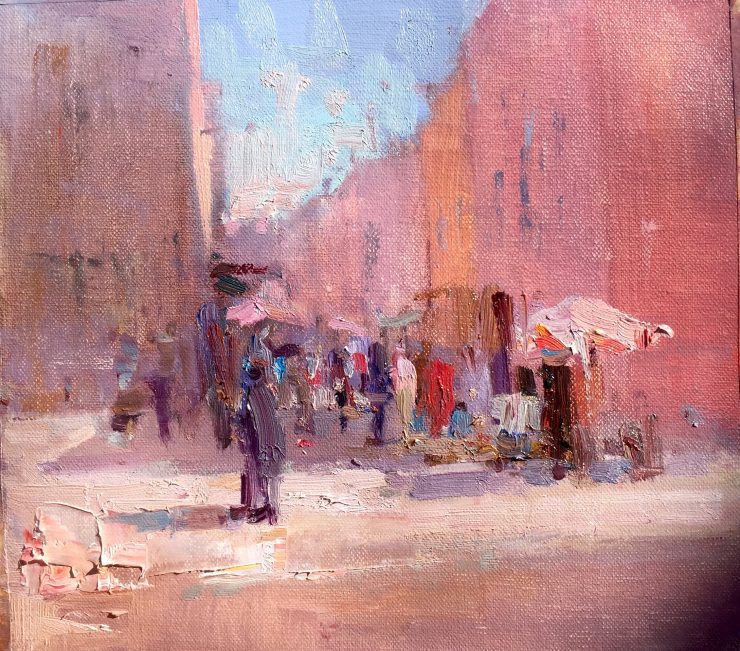







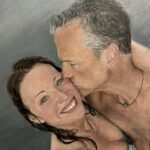
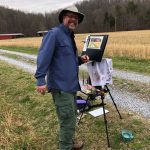


































Barry, when you say ‘pure pigments’, do you mean the oil colours on the palette, thinned down, or powdered pigments you hide somewhere?
I started off with oil colors on the palette, without any white added. Later on I added white into the mix.
Thanks for a great video, Barry. I like the fact that it is un-edited- it made me chuckle on several occasions, seeing what you were dealing with with people coming and going and the scene changing all the time. I haven’t been game to paint in a similar situation just yet, preferring to find more isolated locations. But , I’m building up to it.
You have really nailed the reflected glow and warmth on the buildings and the feeling of hustle and bustle.
I was also interested to see your palette. You certainly put out a lot of each colour. What do you do with the paint left on your palette at the end of a session/day? ( many of which seem not to be used at all for this painting.)
Congratulations on making such a beautiful painting.
I put plastic wrap over the palette and press it around all the piles of paint to exclude the air. This stops the paint drying out.
At home I then put the whole palette in the freezer to further reduce the drying of the paint.
But as you noticed, in Morocco I didn’t use these grays as much as I normally do. This is because the colors were so intense. Sometimes you need to adjust your working methods according to the subject and atmosphere, as I certainly have been doing with these North African painting series.
Excellent information about light. I never knew this but it makes so much sense.
What is your opinion of the the carder method? Or mark carders way of teaching in general?
That is a very good question Yvon. The answer is a bit complex.
The Carder method and similar methods taught in many classical ateliers, are very good for helping you make an accurate copy of a still life setup or a model in the studio. The process is fairly mechanical and can be learned with a bit of practice and can produce good results if what you want is an accurate copy of what you see in front of you.
However there are serious limitations with it from an artistic point of view.
The first major problem is that the Carder method use a method of drawing called sight-sizing. Sight-sizing constrains you to making an exact copy of what you see in front of you. But if you simply copy what is in front of you, you will end up with a painting that is no more artistic than just taking a snapshot with a camera.
To make a good composition you need to re-organize the chaotic shapes of nature into interesting and varied patterns. Organizing nature into these patterns is what the ‘art’ in painting is all about.
So what you need to learn instead is how to see relationships. That is the best way to learn to draw. Then you you can easily move mountains, re-arrange trees, and create something far more interesting than what is actually out there.
Secondly, these methods rely on something called a color isolator. There are two problems with this tool. Using a color isolator to create an exact match between a colors in a still life setup and your paints, works fine in the low lighting levels typically found in the studio.
But it runs into major problems when you try to use this method outdoors. In the studio, the level of light coming off the lit and shaded parts of your subject is about the same as the level of light reflecting of the painted light and shade areas on your painting. So you can use a color isolator to make sure the colors on your painting and the colors in the scene are identical.
Outdoors things are totally different. You can put your painting in the shade and use the color isolator to match the shadows in your painting with the shadow color in the scene. So far so good. But as soon as you try to do that with the light parts of the scene you find that it is impossible. The light coming from a bright sky is far greater than the the light coming from the lightest part of your painting in the shade and so you simply cannot match the colors – the lightest part of the painting always appears far too dark.
But there is a second problem as well. Again, in methods such as the Carder method and similar methods, they teach you to copy exactly the colors of nature. This means you cannot gray colors down, or increase the saturation to create a more interesting color harmony. This tends to result in rather boring paintings from a color point of view. What you really need to do when painting outdoors is to learn how to see color temperature and value relationships and then exaggerate them to create a more artistic and creative effect.
Also if you create the feeling of light you need to change the colors you see. If you just copy the colors, the painting will just feel dull.
So the bottom line is that these methods produce rather mechanical results that are an accurate copy of nature, but without any significant degree of artistic interpretation. In essence you are learning a craft and if you rely on these methods like a crutch, you will be quite handicapped when it comes to the more creative side of painting.
Thank you sir for the response. That’s why I’m trying to learn your method. I guess I find it more “loose”. Artistic? Individualistic? Not trying to make a Painting look like a photograph…..I must say there are things that I’m having trouble with. The concept of notan, and squinting…..I guess it will all come together
Yes like most things that are worthwhile, it takes some time to learn and practice the skills, but eventually you will get there. It just takes a patient commitment to work on it, and to gradually build up the skills you need one by one. Good luck!
Hi Barry. Sorry to bother you again. Lesson A10. You place pints on your palette but don’t specify what colours. Can you elaborate please?
All of the colors and all of the palettes are detailed in the Virtual Art Academy eLibrary: Color Unit Two (type color unit in the search box to find it).
There is also a tool here to help you select the right palette: https://www.virtualartacademy.com/how-to-choose-oil-colors-tool/. If you click the top right … menu and look for Free Guides, you will find the tool.
I hope this helps you.
Barry
Beautiful work.
The colors are so rich and at the same time natural. The play of colors in shadows and the lights makes this painting sing.
One question if you use zinc white for under layers or you keep to titanium white.
I use titanium white, but in a very thin wash to keep it transparent.
I think it was good to start with warm imprimatura colors. It helped establish the warmth of the atmosphere. And also I agree not to depend on photographs but go with your gut feeling of what you want to convey. Good job, Barry!
Really useful! Thank you, Barry!